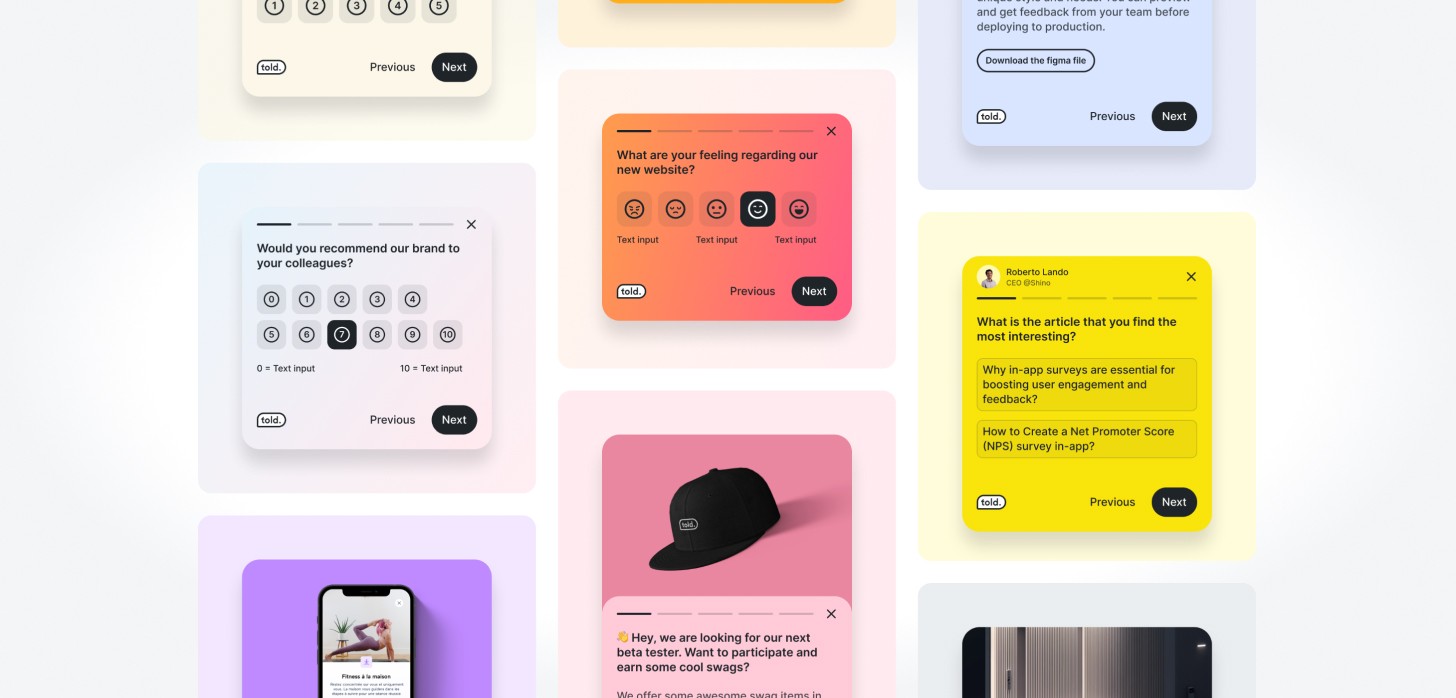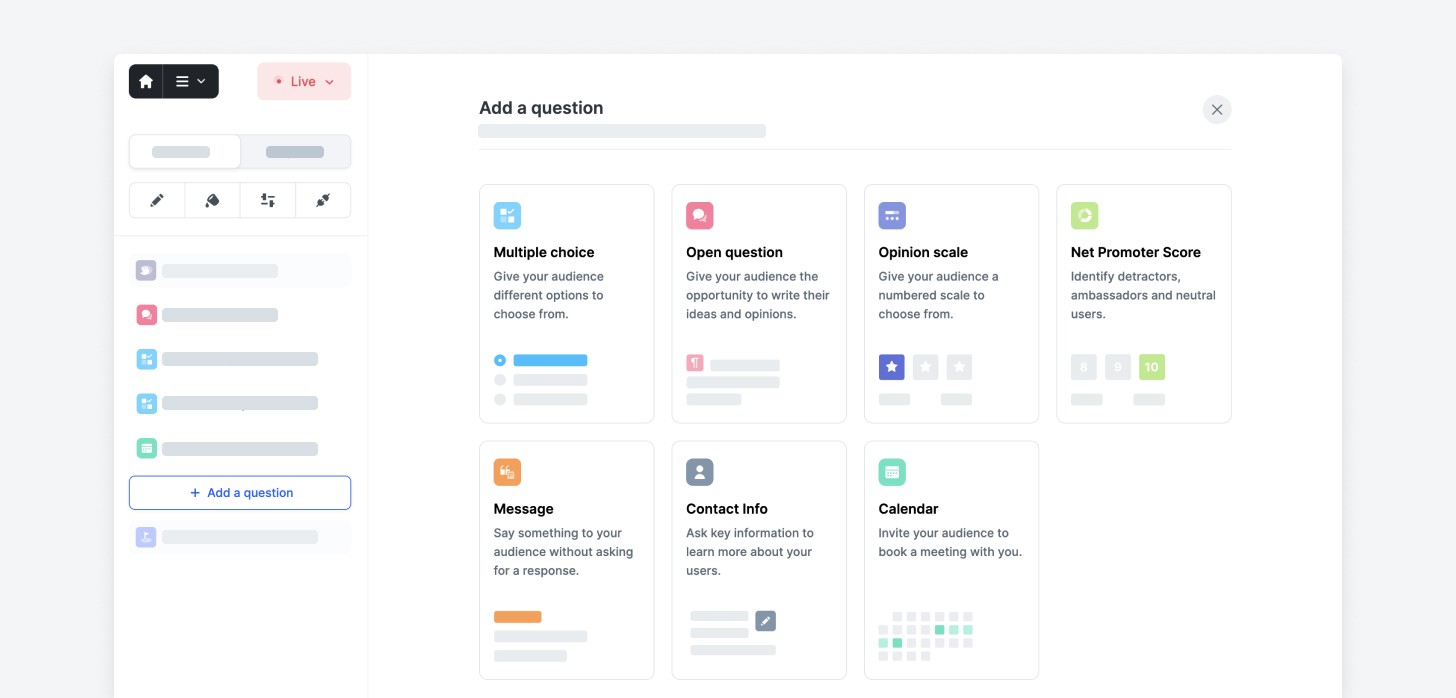50+ survey questions to ask your users
User Engagement

Nicolas Jaussaud
Sep 5, 2023
The quest to understand your users can quickly turn into a headache. We tend to take two divergent paths: thinking we've got some kind of crystal ball, assuming without checking our assumptions, and the second, conducting an investigation to shed light on our assumptions.
As you might guess, this article isn't about improving your skills as a magician. Rather, it's about how to make better use of a practical method for understanding the thoughts and feelings of your audience, namely user surveys.
We'll briefly remind you why surveys are important, then provide a set of over 50 questions you can use to create your own surveys.
Why are user surveys so important?
Understanding your users' preferences, opinions, and pain points is crucial for delivering a user-centric experience. Surveys offer a direct line of communication with your audience, allowing you to tap into their thoughts and feelings. By collecting data through surveys, you can:
Refine your product strategy: Discover the features and/or improvements your users really want.
Enhance customer satisfaction: Address issues and concerns that might be hindering a positive user experience.
Tailor your pitch to sell more: Craft targeted campaigns based on the preferences and demographics of your audience.
Better define your target by collecting data on your respondents' profiles.
Asking effective survey questions
The effectiveness of your survey lies in the quality of questions you ask. Poorly formulated questions will lead to ambiguous or irrelevant responses (or no responses at all!). Here's how to create survey questions that yield valuable insights:
Be clear and concise: Use simple language and avoid jargon to ensure your questions are easily understood.
Avoid bias: Phrasing can influence responses. Keep your questions neutral to get genuine feedback.
Use a mix of question types: Combine multiple-choice, open-ended, and rating scale questions for comprehensive insights.
Progress from the general to the specific: Start with broader questions to build context before delving into specific details.
50+ survey question examples

We've compiled a diverse range of questions that cater to various industries and survey objectives:
Customer Satisfaction:
On a scale of 1-5, how would you rate your experience with us? (CSAT question)
How likely are you to recommend [company] to a friend or colleague? (NPS question)
How likely are you to use this product/service again?
Would you use our product/service again?
Please rate the overall support experience.
Product Feedback:
How did you hear about [our product/service]?
Does [our product/service] help you achieve your goal?
What features do you find most valuable in [our product/service]?
How would you rate the ease of use of [our platform]?
Are there any improvements you'd like to see in [our product/service]?
How could we improve [our product/service] to better meet your needs?
How easy was using [our feature] so far? (CES question)
What product feature is the most valuable to you?
What product feature is the least valuable to you?
What features would you like to see in the future?
Have you tried any other similar products before?
Website Experience:
How did you learn about our website?
How easy was it to find the information you were looking for on our website?
What improvements would you suggest for our website's navigation?
Do you feel you had to click around too much to get what you were looking for?
Did this article help you?
Is there anything missing on this page?
Did the website take too long to load?
E-commerce Website:
How did you find our store?
Did you find a wide enough range of products?
On a scale of 0-10, how much do you trust the product reviews?
How is our product different from that of competitors?
How satisfied are you with the checkout process and payment options?
What factors influenced your decision to make a purchase from our e-commerce store?
Post-Purchase E-commerce:
What do you love about your purchase?
How satisfied are you with the quality of products?
On a scale of 0-10, how satisfied are you with the quality of products?
Would you refer us to a friend?
What is your first impression of the product packaging?
Pricing Strategy:
Are the pricing options clear?
How often do you purchase this type of product?
What is the ideal price for this type of product?
What price range would make you consider that the product is too expensive?
At what price would you think the product is getting expensive, but you still might buy it?
Cancellation & Abandoned User Flows:
What are the reasons you’ve decided to cancel your account?
Why did you cancel your subscription?
What made you leave our website?
Demographic Questions:
What is your gender?
What is your age?
What is your ethnicity?
What is the highest level of education you have completed?
What is your annual income?
Which languages do you speak?
Where do you live?
Are you married?
Questions about the company and position:
What is your company name?
What is your company size?
How big is your company? (Prefer the use of scales to avoid losing your respondents (e.g. 1-10, 11-50…).
What do you do for a living? (suggest a predefined list, but leave an open-ended question for more details)
What is your annual income?
What is your company's sector? (Retail, Industry, Healthcare…)
What is your company's market? (B2B/B2C/B2G/B2B2C…)
Selecting between the different types of questions

Now let’s talk about actually using these 50+ different survey questions. Maximizing your response rate starts with choosing the right kind of question. At Told, we offer the following question types:
1- Multiple choice
Multiple choice questions give users a few options to choose from. They’re useful when you need quantitative data or want to easily categorize the responses. They also tend to get higher response rates, as the user doesn’t have to put much thought into their answer. This makes them useful for asking about which product features the user prefers, or for demographic information such as age, gender, etc.
2- Open question
Open questions ask the user to provide their own non-structured answers. They’re ideal for gathering qualitative comments and opinions. These questions can be used to gather user suggestions or personal experiences, for example, by asking users for their opinions on what could be improved within the product.
3- Opinion scale
Opinion scales are used to measure the user’s sentiments and feelings regarding their experience via a numerical scale. This is most often a scale of 1-5 or 1-10. The questions are excellent for obtaining quantitative data that reveals user preferences. They can be used for evaluating user satisfaction or seeing how a product is perceived.
4- Net Promoter Score (NPS)
NPS is a measure of user loyalty and their willingness to recommend a product/company to others. A typical NPS question is “On a scale of 1-10, how likely are you to recommend our product/company to a friend or colleague?” This type of question lets you divide users into categories such as “promoters”, “neutrals” and “detractors” and gives you a quick view of overall satisfaction.
5- Contact info
These questions are used to gather user contact information, such as their name, email, and/or telephone number. (Told is the only supplier on the market who offers these questions in a 100% GDPR-compliant fashion.) In order to respond, the user needs to have read and accepted the site’s confidentiality policy.
6- Calendar
These questions allow users to select either a single date or a range of dates. They can be used to set up meetings, events, or to simply obtain user availability data. For example, you could use a calendar question to set up a demo with a salesperson.
How can you create your own survey?
Told is the perfect tool for creating your own surveys, publishing them via link or directly on your website. You can try it for 14 days without entering a credit card.
So if you want to get your survey up and running quickly, sign up for your free Told account.







